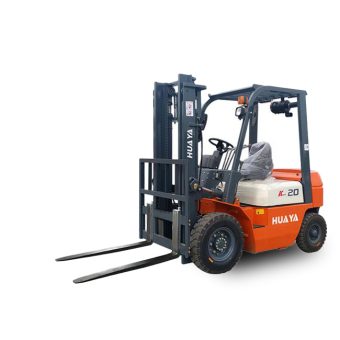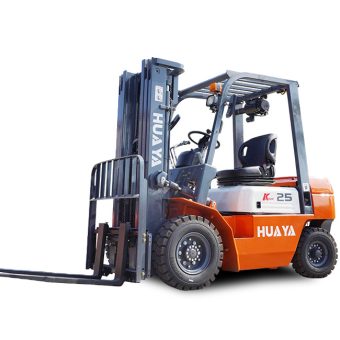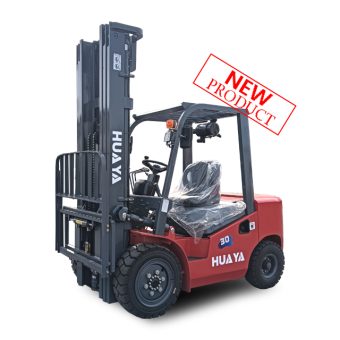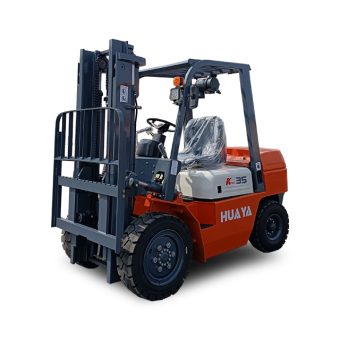
Noticias
Forklifts are powerful machines, but when mishandled, they can quickly turn dangerous. One of the most serious accidents is a sideways tip-over. Unlike a forward tip-over, which usually involves an overloaded mast, a sideways tip-over often happens suddenly and without warning. The result? Serious injuries, damaged goods, and even fatalities. So, what actually causes a forklift to tip over sideways?
The secret to forklift stability lies in the stability triangle. Imagine a triangle formed between the two front wheels and the center of the rear axle. As long as the combined center of gravity of the forklift and its load stays inside this triangle, the forklift remains stable. But if the center of gravity shifts outside, that’s when tip-overs occur.
Load placement, operator handling, and surface conditions all influence this delicate balance.
Excessive Turning Speed
Turning too quickly is one of the leading causes of sideways rollovers. The momentum pushes the forklift’s weight outward, shifting the center of gravity beyond the stability triangle.
Sharp or Sudden Turns
A forklift isn’t a sports car. Sharp turns at high speeds can make it tilt sideways in an instant.
Uneven or Sloped Surfaces
Driving across ramps, potholes, or uneven flooring increases the chance of losing balance. A small tilt in the surface can push the load past its stable position.
Carrying an Unbalanced Load
If the load is leaning or distributed unevenly, the forklift’s balance is compromised. This is especially risky during turns.
Sobrecarga de la carretilla elevadora
Every forklift has a maximum capacity. Exceeding it places stress on the mast and shifts the center of gravity dangerously outward.
Driving with an Elevated Load
Keeping the forks raised while moving raises the center of gravity, making the forklift unstable, especially during turns.
Hitting Obstacles or Curbs
Even a small collision with a curb or pallet corner can destabilize the machine enough to cause a tip-over.
Sudden Braking While Turning
Slamming the brakes during a turn shifts weight abruptly, often leading to a rollover.
Improper Tire Inflation or Damage
Uneven tire pressure causes imbalance, making the forklift prone to sideways tipping.
Operator Error and Negligence
Inattention, distraction, or ignoring safety rules plays a huge role in many accidents.
Poorly maintained floors with cracks or uneven sections.
Wet, oily, or icy surfaces reduce traction.
Tight warehouse spaces force operators to take sharper turns.
Many accidents happen because of simple mistakes like ignoring load charts, failing to slow down in tight areas, or not understanding how a load’s position affects balance. Lack of training is often at the root of these errors.
Forklift design itself influences stability:
Counterbalance weight keeps the forklift grounded.
Tire type and width affect grip and stability.
Center of gravity varies between electric, diesel, and rough-terrain forklifts.
Picture a warehouse worker rushing to meet a deadline, taking a sharp turn with a raised pallet—suddenly, the forklift tips. Or an outdoor operator driving across a sloped gravel yard—the uneven surface causes an unexpected rollover. These aren’t just possibilities; they’re real incidents reported every year.
Proper training and certification are non-negotiable.
Safe turning techniques should always be followed.
Speed control helps prevent sudden imbalance.
Keep loads low and properly balanced.
Inspect floors and surfaces before operating.
Modern forklifts come with features like seat belts, overhead guards, and electronic stability systems that reduce the risk of rollovers. But no technology can replace careful operation.
Employers must ensure:
Operators are trained and certified.
Forklifts undergo regular maintenance.
Safety rules are enforced consistently.
Operators should always:
Keep loads low when moving.
Avoid sudden turns and stops.
Respect load limits.
Perform pre-shift checks on tires, brakes, and hydraulics.
OSHA has strict regulations for forklift safety. Employers who ignore them risk fines, lawsuits, and costly downtime. Beyond the legal side, accidents damage reputations and bottom lines.
The golden rule? Never jump out during a tip-over. Staying inside with the seat belt fastened and holding on tightly offers the best chance of survival.
Forklift safety isn’t just about one operator—it’s about building a culture. Continuous training, open communication, and strict adherence to protocols save lives and money.
A forklift tipping sideways is rarely caused by a single factor—it’s usually a mix of speed, load handling, surface conditions, and operator behavior. The good news? Almost all tip-overs are preventable with the right training, awareness, and equipment care. Safety isn’t just a rule; it’s a mindset that keeps everyone safe.
Excessive turning speed combined with an elevated load is the leading cause.
Yes. Even a small slope or bump can push the center of gravity outside the stability triangle.
No. Stay inside, hold tight, and keep your seat belt fastened—it’s the safest option.
Absolutely. Rough-terrain forklifts have wider tires for stability, while narrow electric forklifts are more prone to tipping.
By enforcing training, maintaining equipment, and creating a safety-first workplace culture.



